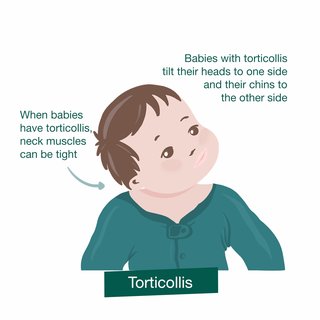Torticollis is a common, easily treated condition in babies. Your baby may have been born with it or have developed it in their first few months.
Your baby may have developed torticollis if they tilt their head down to one side or avoid turning their head in one direction.
Most babies with torticollis get better through position changes and stretching exercises. Depending on your baby's age, it may take weeks or months to fully correct.
Check if it’s torticollis
Your baby might have torticollis if they:
- tilt their head in one direction
- prefer to look in one direction
- prefer breastfeeding on one side (if they are breastfed)
- are reluctant to look the other direction
- are unable to turn their head one direction
- are uncomfortable lying on one side of their body

Urgent advice: Ask your GP or public health nurse (PHN) for an urgent appointment if:
- you notice any of signs of torticollis in your baby
They may refer you to a paediatric physiotherapist (a physiotherapist that works with children).
Some babies with torticollis develop a flat head (positional plagiocephaly) on one side from lying with their head turned in one direction all the time.
There may be a small benign (harmless) lump on the muscle of your baby’s neck. This lump often disappears by itself over time.
Treatment for torticollis
Your paediatric physiotherapist will show you:
- ways to carry and position your baby
- changes you can make to your baby's environment
- some neck stretching and strengthening exercises
These exercises will help:
- loosen the tight muscles
- strengthen the weaker muscles on the opposite side
- support your baby’s development - such as gaining head control
Your baby will continue to see the physiotherapist until their torticollis has gone.
Helping your baby at home
Encourage your baby to turn their head in both directions.
Tips to help your baby's torticollis:
- When your baby wants to eat, offer their bottle or your breast in a way that encourages them to turn away from their preferred side.
- Use toys to encourage your baby to look in both directions.
- Reposition your baby when they’re sleeping so that their head is turned away from their preferred side. Always lay your baby on their back when they sleep to lower the risk of cot death.
- Put your baby on their tummy to help strengthen their neck and shoulder muscles during tummy time.
- Lie your baby on the side they are tilting their head to when they're awake - this gives a gentle stretch to their neck muscles. If you need to, use a rolled-up towel behind their back to support them.
Cause of torticollis
Torticollis may be caused by tightness in a muscle on one side of your baby’s neck. This will cause your baby’s head to tilt down and turn towards one side.
Your baby may have torticollis because:
- they did not have enough space for their head in the womb
- of how they were positioned in the womb - for example, if they were breech
- a forceps or a vacuum device was used during their birth
- they preferred turning their head in one direction after they were born
Talk to your PHN, GP, or physiotherapist to find out the cause of your baby’s torticollis.
